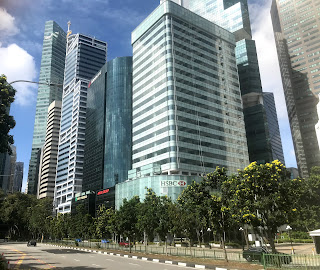Singapore’s central business district is centred on Raffles Place, originally named Commercial Place. The square was a central part of the 1822 town plan, which divided the two banks at the mouth of the Singapore River into a civic area to the east and commercial area to the west. A number of commercial buildings including banks and trading houses were developed in this area through the colonial period. Most of the these buildings have been demolished and replaced with modern highrises though there are still a few colonial remnants here and there.
One of the most prominent of these remnants is the old General Post Office from 1924-28. Located one block away from Raffles Place at the mouth of the Singapore River, the building was the largest project developed for the occasion of the centennial celebrations in 1919. The design was by architect Keys & Dowdeswell, who also designed the Capital Theatre and Singapore General Hospital. It was the third GPO on the site, the first was built in 1873 and the second in 1885. The post office had previously been housed in a building near the city hall, since 1854. The GPO was rebuilt to become a hotel in 1997-2001 and is now the Fullerton Hotel Singapore.
Just across the road and near the corner to Raffles Place stands the Bank of China building. This was one of the first highrises in the area and was completed in 1954 to a design by architects Palmer & Turner. The same architects designed similar towers for the Bank of China in Hong Kong (1952) and Shanghai (1937). A second 168m tower was completed on an adjacent site and to a similar style in 2000.
Also near the waterfront but to the west at the opposite end of Raffles Place was built another highrise in 1953-55. The Asia Insurance Building was built to a design by architect Ng Keng Siang and was once the tallest building in Singapore, at 87 metres. The building was converted to serviced apartments in 2008 and has been renamed Ascott Raffles Place.
The old waterfront on Collyer Quay was somewhat reminiscent of Shanghai’s Bund in the first half of the 20th century. Prominent commercial buildings included the HSBC building and Union building.
But things have since moved on. In 1979, a new HSBC building replaced the previous one from 1924. The resulting tower was reclad in a new facade in 2006. Next door, the Union Building was replaced with another tower in 1982-84. Previously known as the Tung Centre, the logo at the top has since been replaced with that of property developer Guocoland. The next tower replaced the 15-storey Shell House from 1960. The old building was put up for sale in 1986 and the new Hitachi tower was completed in 1992 to a design by Murphy/Jahn Architects. It is linked with a similar tower facing Raffles Place that was previously named Chevron House.
The OCBC Tower was built about two blocks up river from Raffles Place in 1976 becoming the tallest building in Singapore and Southeast Asia. The tower was designed by architect IM Pei and reaches to 197.7 metres. It replaced an earlier OCBC headquarters from 1932, which was built to a design by architects Keys & Dowdeswell and was known as the China Building.
One Raffles Place was the first of three towers on or near Raffles Place to reach 280 metres, which is the height limit for tall buildings in the area due to the proximity of Paya Lebar airbase. Built as the OUB Centre and completed in 1986, it was then the tallest building outside North America. The architect was Kenzo Tange. A new tower was completed on an adjacent site in 2012. One of the buildings that stood one the site previously was Robinsons Department Store, which was destroyed in a fire in 1972.
UOB Plaza was completed in 1995 to a design by Japanese architect Kenzo Tange. It consists of two towers joined by a podium. The earlier tower is from 1974 but was redesigned as a smaller twin to UOB Plaza 1, which became the second tower in the CBD to reach 280 metres in 1992. The Bonham Building was one of the earlier buildings on the site of the smaller UOB Plaza 2.







No hay comentarios:
Publicar un comentario